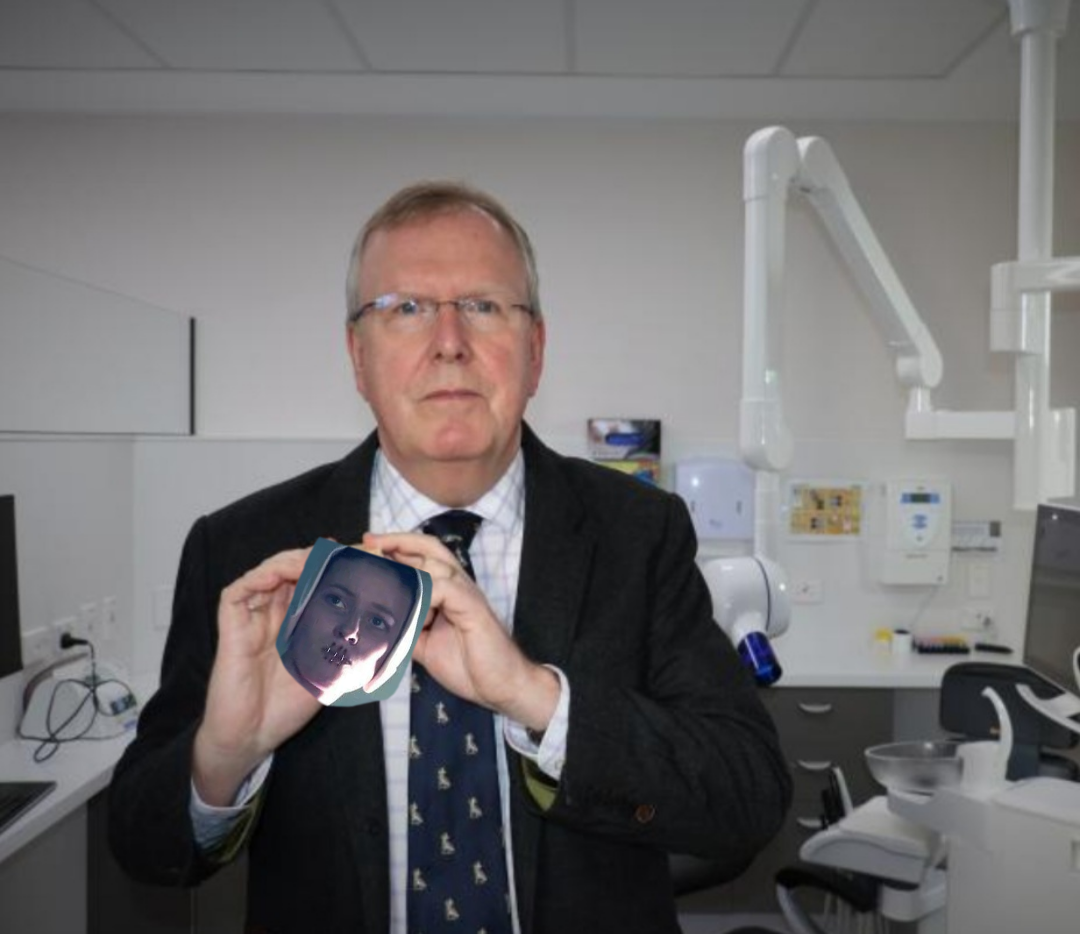Life in the age of COVID has felt increasingly dystopian, and the weight loss industry is apparently embracing this theme, with the launch of “Dentalslim”, a heinous dental contraption, ostensibly an “improvement” on the good old days of jaw wiring. The Dentalslim uses metal brackets, magnets and BOLTS to shut the jaw. Once fitted, chewing or moving your jaw is next to impossible, you can only drink liquids through a straw.
I won’t re-post the pictures of the Dentalslim because they are legitimately traumatising. It’s hard to believe that a mild mannered group of New Zealand dentists not only dreamed up something straight out of The Handmaid’s Tale, but then promoted it AS A WEIGHT LOSS PRODUCT, but on the surface that seems to be what has happened.

Lead Researcher Pro-Vice-Chancellor Prof Brunton
(image edited to be less disturbing than real life)
This all started with a press release from Otago University in New Zealand, which spruiked the results of a feeble pilot study featuring the Dentalslim, published in the British Dental Journal. The lead researcher was Otago University’s Pro-Vice-Chancellor Professor Paul Brunton (AKA Commander Brunton), who claimed that the Dentalslim is “a non-invasive, reversible, economical and attractive alternative to surgical procedures.”
“Non-invasive and attractive???”
If you’ve seen the pictures of it, you’ll know why this statement is terrifying!
The weight loss industry are on fire at the moment, using the fact that diets don’t work not to leave fat* people the f*ck alone, but to push ever-more intense “treatments” for a “disease” that doesn’t even exist. Fat bodies are no more a “disease” than bald men are. The fact that bolting the jaws of larger people shut and then starving them is seen as less invasive than weight loss surgery and potentially a reasonable idea is really saying something.
The pilot study itself was NOT ground breaking. Seven naughty handmaids fat white women were magnetically bolt-muzzled and then sucked diet milkshakes through a straw for 2 weeks. There was no ‘control group’ (no control group = BS alert). The paper mentions a “safety feature” to release the Dentalslim “in case of an emergency such as a panic attack or where a possibility of choking arises”. According to the trial register information this is a kind of metal mouth-shoehorn which you are supposed to use to ply your mouth open and disengage the magnets. I personally can’t imagine having the presence of mind to practice my mouth shoe-horning skills mid panic attack/choke, but maybe that’s just me?
Over two weeks, there was an average 5% weight loss, which is not surprising given the women were on a straw sucking liquid diet. Two women didn’t finish the study. Two weeks after their torture device was removed, the women were re-weighed and – surprise surprise – the weight was returning! These kinds of ‘results’ drive me AROUND THE BEND – it is NOT news to find that if you starve people, they (temporarily) lose weight. We already know this, AND we know that weight cycling is not good for human physiology or psychology. But this was not discussed, the researchers just celebrated the short term weight loss.
Crediting the mouth prison for temporary weight loss is ludicrous. It beggars belief that this is even considered to be remotely ‘useful’ above and beyond the existing weight loss shakes on the market (and I am not for a minute saying that they’re any good whatsoever, but SWEET LORD look where we are right now). It’s literally like building a prison, sticking women in it, feeding them weight loss shakes, and then using the ‘results’ to sell more lady prisons. UTTERLY LUDICROUS and why are we even here?
The authors had a stab at evaluating what they called the “tolerability” (ie, how awful was it?) of the Dentalslim. The women listed all sorts of harrowing consequences, including bad oral hygiene, trouble pronouncing any words, pain,and finding their lives less satisfying. I counted 17 reported negative aspects, directly caused by the Dentalslim. But Commander Brunton had the NERVE to tell the media “The fact is, there are no adverse consequences with this device.”
It gets worse. Even though these women were starved, couldn’t speak properly, experienced pain, and found life less satisfying, the authors said “Nevertheless, all the participants got accustomed to the device during the treatment period and were able to work effectively in their usual employment”.

Still able to work! #Underhiseye #OfBrunton
The whole paper is utterly chilling, and the fact that all of the subjects in the study were women is both terrible and typical. The sexism in this dark little corner of the weight loss world is next level. The history of jaw wiring is quite literally the history of shutting women up. Interest sparked during the late 1970’s, not long after the Stepford Wives movie was released. A cluster of (male) Commanders dentists dallied with it, and there was a (mercifully brief) flurry of research articles published. I read most of them (yes I went down that rabbit hole!). Across five studies, totalling 214 jaw-wired humans, 210 of them were women! (Castelnuovo-Tedesco et al, 1980, Goss et al, 1980, Rodgers et al, 1977, Ross et al, 1983, Garrow & Gardiner, 1981).
These articles make for really alarming reading. The list of “side effects” is long, including severe hair loss and “acute psychiatric decompensation” (Goss, 1980, Harding, 1980). In several papers, there were descriptions of women resorting to wire cutters in a desperate bid to open their mouths. Mercifully, the trend did not last, as researchers realised that the dramatic weight loss was almost always followed by just as dramatic regain. And the experience was so downright unpleasant that even in the super-sexist 1980’s, it was all but abandoned.
Those sexist dentists were strangely much more honest about the reality of jaw wiring than the spin doctors of today. Here’s an extract from a 1980 paper which sums it up:
“The initial response of most patients to jawwiring was one of enthusiasm. At first, they were very excited by their weight loss, pleased that they finally had discovered a method that “worked” and that they had done something “active” about a problem that had plagued them for years. The mild chronic depression noted during the initial workup typically would lift and patients remarked that they felt much better, more energetic and “alive” than they had in years. They enjoyed the compliments and encouragement that they usually received from family members and friends. After the early enthusiasm, however, and generally by the end of the first jaw-wiring period, patients’ reaction changed. Their sense of accomplishment gradually was replaced by discouragement, apathy, and irritability similar to features seen initially. This coincided with the observation that weight loss was slowing down and, in some cases, that weight actually was being regained. Reactivation of interpersonal (often marital) problems was common. When this topic was broached, patients readily acknowledged that they were “cheating” on their diets and that they felt upset…they appeared to respond to a sense of being emotionally deprived and physically restricted.” (CastelNuovo-Tedesco et al, 1980)
Commander Brunton and colleagues have stopped the music at the “honeymoon” stage of jaw wiring 2.0, and seem intent on building a case for mass production built on this straw house.
So we are faced with a mystery – why has this torturous practice of jaw wiring resurfaced? Who are these people? We know that four of the study’s authors, including Dr Brunton, are academics from the University of Otago’s Faculty of Dentistry. There’s also 2 authors from the UK, Jonathan Bodansky and Richard Hall. I had a little dig around and found that they both work at Leeds University, although oddly, they did not list their university positions in the research paper. Instead, Dr Bodansky listed his position as consultant physician at Leeds teaching hospital.

Commander Bodansky
His web page states that his areas of specialty are in general internal medicine and diabetes (he is also very interested in erectile dysfunction). Oddly, his website states that he was also ‘listed by Tatler magazine as one of its top 250 doctors’.

Commander Hall
The other UK author is the mysterious Richard Hall of ‘RMH Consultancy’. He is also a professor at the University of Leeds, in the school of mechanical engineering, where his specialties are listed as biomechanics, medical engineering, and (hint) medical devices.
So here is where the mystery reveals itself. Although Dr Hall was the Director of RMH Consultancy (from June 2017), in October 2018 the company changed names to become Dentalslim Production Management Limited. And in July 2019, Dr Bodansky became a Director of Dentalslim. There are 3 shareholders listed – Dr Hall (40%), Dr Bodansky (30%), and the University of Otago (30%).
The press release doesn’t mention who created the Dentalslim device. But in the study there is reference to a 2003 patent, which shows that the original inventor was none other than Dr Hall. Some technical aspects of the device were produced by a company called Technovent, (a company who manufacture magnetic dental devices) which is interesting as Dr Hall was also the Director of Technovent for nearly twenty years (between 1991 and 2010). In 2002, Dr Hall even appeared in an article in The Guardian, talking up his magnetic dental devices as weight loss aids and alluding to a “clinical pilot study” planned for later that year, which never materialised in published literature. Between 2002 and 2018, Dr Hall was Director of another dental implant company called “Magna-Chewd”, and owned the trademark. And lo and behold, the trademark for Magna-Chewd is almost identical to the Dentalslim one:


There’s clearly a long history of Dr Hall’s commercial interests in making magnetic dental weight loss devices. This whole horror show now makes sense: The New Zealand dentists are helping Dr Hall’s dystopian weight loss dreams come true. And they’re all looking forward to profiting off it!
In July 2016, when the proposal for the jaw clamping experiment went past the Ethics committee, questions about commercial interests were asked. Somehow, the committee ended up concluding that they were “satisfied that your study is not a clinical trial that is to be conducted principally for the benefit of the manufacturer or distributor of the medicine or item being trialled”. Note that no-one in the Ethics committee mentioned ANY concerns about the inhumanity of the Dentalslim – apparently the horrendous idea of a dental chastity belt didn’t raise an eyebrow. Hello fatphobia!
Without being present at the Ethics meeting, it’s impossible to know how much the committee actually knew about Dr Hall’s prior involvement with dental weight loss devices. Perhaps they did know, and thought it was ok? But it is weird that in the research paper and all of the press releases, he is listed under the defunct RMH Consultancy name, and mentions of Dentalslim (or even Magna-Chewd), are conspicuously absent.
Of course, it’s not unusual for inventors to want to get their ideas on the market, or even for universities to develop commercial partnerships. But the glaring, HUGE problem with all of this is that no conflicts of interest were declared in the research paper. And, at no point in ANY of the press releases or news articles are the commercial aspects of this venture disclosed.
Conflicts of interest are important, and required by each journal. By the time the paper was submitted and then published, all of the authors were either shareholders or Directors of the Dentalslim Limited company, and the University of Otago was even bragging about their commercial partnership in their 2019 Annual Report. I have written to the Editor of the British Dental Journal pointing out the urgent need for a proper disclosure of conflicts of interest, and hope to have a response to share with you ASAP. It’s a start!
Epilogue
Just as I was about to press “publish” on this blog, in response to the torrent of universal anti-Dentalslim outrage, Commander Brunton has doubled down in a recent news article, defending his cashcow paper. Bringing the entire issue of sexist dental weight loss torture devices back to his man-feelings, Brunton told the press that he was ‘hurt’ by the valid concerns of people pointing out that it is fatphobic, ineffective, unecessary and inhumane. He then said that the magnetic ladymuzzle is ok, because his ‘colleagues’ (the rest of the Commanders?) have given him ‘positive feedback’.

But Fellow Commanders LOVE The Dentalslim
Brunton said that this has all been a big misunderstanding, and wants everyone to know that fat women won’t be FORCED into Dentalslims – apparently it is a “choice”, available for excellent situations like when you’re being denied medical surgery unless you lose weight. Just like in Gilead, where fertile women could “choose” between the colonies or becoming a Handmaid. To put it simply, in situations of forced choice due to the domination of oppressive regimes, – then the magnetic ladymuzzle is right there for us. Praise Be!
This latest news article also features some devious bro-code. Coming into bat for his fellow Commander is Professor Jim Mann, also from the University of Otago, who was quoted admonishing the rest of the world for making “inappropriate comments”. He thinks that people are upset because they “have clearly not read the paper.” Well Jim, I have read the paper, and if anything I am MORE, not less, disturbed having done so.
In a presumed effort to present a picture of ‘objective’ support, the article stresses the point that Professor Mann “was not involved in developing the device”. However, the ANZCTR lists him as a category “1” collaborator for the pilot study. Responding with defensiveness to worldwide condemnation is bad enough, but trying to gaslight us by once again hiding the true nature of the underground Dentalslim alliance is THE LAST STRAW.
* My use of the term ‘fat’ is intended as a neutral descriptor of physical characteristics, as in ‘tall’ or ‘short’ – not a derogatory comment.


